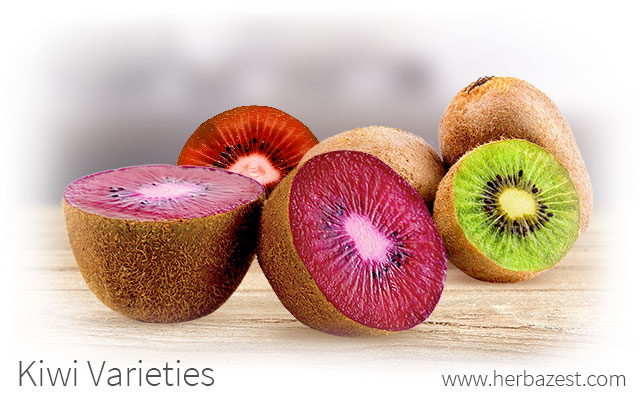With countries worldwide participating in kiwi cultivation, different kiwi varieties have developed. Characteristics such as flavor, shape, and storage life can help identify the type of kiwi variety.
Evolution of Kiwi
The kiwi fruit origin can be traced to Asia. The Actinidia plant was first grown in northern China for nearly 300 years before it was introduced to other nations. The Chinese kiwi fruit, known as Actinidia chinensis, was exclusively found in that Asian country until 1905, when it was first brought to New Zealand, where rapid cultivation began.
At first, the New Zealand kiwi fruit was thought to be the same as the original Chinese plant; however, as recently as the 1980's, it was decided that there were enough differences to warrant separate species.
A. CHINENSIS (CHINESE) AND A. DELICIOSA (NEW ZEALAND) SPECIES ARE BOTH CONSIDERED AS CLOSELY RELATED, BUT ENTIRELY DIFFERENT TYPES OF KIWI.
One of the biggest differences between the two species is the hairy skin of A. deliciosa compared to the smooth exterior of A. chinensis. Generally, A. deliciosa produces a slightly larger fruit than A. chinensis, with a longer shelf life. More distinct differences can be spotted by identifying the different kiwi varieties within these two species.
Kiwi Varieties
Now that kiwi has become so popular, it is being cultivated in countries all over the world. While the environmental conditions in these places are very similar, natural and man-made differences in shapes, textures, flavors, and nutrient content have led to the classifications of different kiwi varieties and cultivars.
Chinese Kiwi Varieties
There are four main types of kiwi in China to be aware of. The most commonly-grown Chinese cultivar is 'Zhong Hua', referred to as Chinese gooseberry. This round to oval-shaped kiwifruit has an average weight of 1.0 - 1.4 ounces (30 - 40 g). Chinese gooseberry has a sugar content of 4.6 - 13% and a range of 26 - 140 milligrams of vitamin C (ascorbic acid) per 100 grams of the fruit. There are three main sub-types that belong to this cultivar: yellow flesh, green flesh, and yellow-green.
Three lesser-known kiwi cultivars are 'Jing Li', 'Ruan Zao', and 'Mao Hua'. 'Jing Li', or northern pear gooseberry, is identified by its elongated oval shape, green flesh, and hairless leaves. 'Ruan Zao' is commonly known as soft date gooseberry and is typically grown in hilly environments. This is a small, sweet berry most often used for jam. 'Mao Hua' has sweet, green flesh and can either be tight or loose haired, with long, thick, oval-shaped leaves.
New Zealand Kiwi Varieties
While the kiwi fruit came to New Zealand much later than its discovery in China, nurserymen were quick to cultivate it, igniting its expansive commercial market. Among New Zealand varieties of kiwi, 'Hayward' is the most commonly-known. It has a light greenish-brown skin with fine hairs that protect the inner fresh green flesh. Other cultivars, 'Abbott', 'Allison', and 'Bruno', share similar properties of green, flavorful flesh and hairy skin, but they are not as popular as the 'Hayward' kiwi fruit.
'HAYWARD' KIWI IS OFTEN REFERRED TO AS 'HOOPER'S GIANT' OR 'GIANT' DUE TO ITS EXTREMELY LARGE SIZE.
Best Kiwi Variety
In today's market, 'Hayward' kiwi fruit is the leading cultivar in New Zealand and, by popular demand, it is exported around the world. 'Hayward' producers include California, Chile, and Italy, where it constitutes 72% of the country's kiwi crop. One of the reasons for Hayward's immense popularity is its superior flavor and its high concentration of kiwi's vitamins. The fresh, succulent taste is captured in a larger fruit that no other kiwi variety or cultivar has yet to match.
Another major factor in the success of 'Hayward' is its long shelf life. While other kiwi varieties can only be stored for two months, the Hayward kiwi can be stored three to six months if kept under good conditions. This longer storage time has been vital for shipping kiwi fruits to far away markets, and therefore has played an essential role in the foundation of the international kiwi industry.
While there are many types of kiwis, the 'Hayward' is considered the best cultivar right now. However, the increasing popularity of the Actinidia fruit, mainly due to kiwi vitamins content, which adds to the many kiwi fruit benefits, may lead to improvements and the rise of new cultivars.
Sources
- Fruits of Warm Climates, Kiwifruit
- Oregon State University, Growing Kiwifruit
- Purdue University, New Temperate Fruits: Actinidia chinensis and Actinidia deliciosa
- Soils, Plant Growth and Crop Production, Volume II, pp. 244-246




